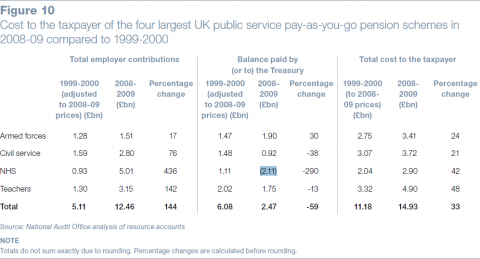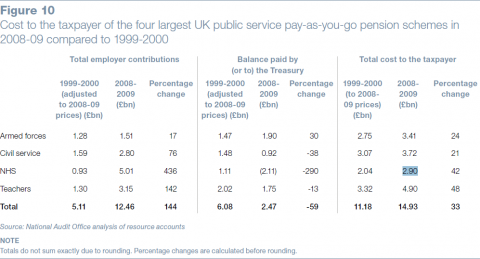Is the NHS pension scheme a drain on the taxpayer?
"Doctors will be in hospitals and surgeries as usual on the day of action. Our pension scheme isn't a drain on taxpayers — it delivers £2billion more to the Treasury each year than is paid out."
Junior doctor Tom Dolphin in The Sun, 31 May 2012
These comments came at the end of a Sun piece reporting the British Medical Association's (BMA) decision to take industrial action over NHS pension reform yesterday.
Dr. Dolphin claimed that the Treasury receives £2 billion from the doctors' pension scheme, and hence it isn't a drain on taxpayers. Is this true?
Analysis
One point to make straight away is that there is no such thing as a pension scheme for NHS doctors alone, which could be understood from the way Dr. Dolphin worded what he said - there is one general NHS pension scheme, of which doctors are a part. However given that the BMA is taking action rather than the entire NHS, the Doctor's phrasing seems fair.
So does the £2 billion figure apply to the NHS pension scheme?
The National Audit Office (NAO) published 'The Cost of Public Service Pensions' in March 2010; the report looked at the four largest UK pay-as-you-go pension schemes (as defined in paragraph one of the report).
Looking down to Figure 10, it's clear that the NHS pension scheme paid £2.11 billion to the Treasury in the 2008-9 year. None of the other three schemes ran a surplus.

But is this the full picture?
It wouldn't be wise to draw too many conclusions from this table alone.
Firstly, Dr. Dolphin claimed that the scheme ran a £2 billion surplus each year. The NAO report only looked at the 2008-9 financial year, so this doesn't say whether this is also reflected in other years.
However a report by Unison published in October 2011 claimed that the net cashflow for the NHS scheme was a (positive) £2 billion in the years ending in March 2008-2010; while the terminology used isn't the same as that used by the NAO report and by Dr. Dolphin, it might well be pointing to the same thing.
The report seems to point towards a Unison-commissioned First Actuarial report for its figure, which might well be looking at the same Treasury payment looked at here. We've asked Unison if we can see a copy of the First Actuarial report, and will update in due course.
So for now, we can only solidly confirm that the £2 billion figure was true of payments to the Treasury for the the 2008-9 year.
Secondly, it's worth having another look at Figure 10 of the NAO report.

The figures in the total cost to the taxpayer column are reached by adding the relevant figures from the two first columns together - that is the employer contriubtions plus the balance paid to the Treasury. For example, the figure for the Armed Forces scheme was reached by adding £1.51 billion to £1.9 billion, bringing the total cost to the taxpayer to £3.41 billion.
Looking at the NHS pension scheme, it's actually clear that, despite the amount of money paid to the Treasury, the taxpayer still effectively paid £2.9 billion into the scheme in 2008-9 - although this is less than the cost of other schemes.
It's also noteworthy that the NHS scheme was the only scheme of the four looked at by the NAO to have been able to pay money into the Treasury, but that does not mean that the NHS is actually making money for the taxpayer.
Conclusion
The £2 billion figure mentioned by Dr. Dolphin was true for the year 2008-9; however, we haven't yet been able to check whether this was actually the case for other years, although we will update accordingly.
However while the surplus paid to the Treasury might, for example, be used to back up a claim that the scheme has been well run - a reader might be lead into thinking that the taxpayer is making £2 billion per year from the NHS pension scheme.
This isn't the case. The £2 billion surplus means that the Treasury gained, but the taxpayer actually faced a cost of £2.9 billion in the same year. This is problematic for Dr Dolphin's claim.